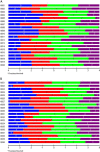Development and quality assessment of the psychometric properties of the Self-Efficacy in Lifestyle Counselling scale (SELC 20 + 20) using Rasch analysis
- PMID: 38395879
- PMCID: PMC10885596
- DOI: 10.1186/s12955-024-02236-z
Development and quality assessment of the psychometric properties of the Self-Efficacy in Lifestyle Counselling scale (SELC 20 + 20) using Rasch analysis
Abstract
Background: Globally as well as in Sweden, diseases that are caused by unhealthy lifestyle habits are the most common causes of death and disability. Even though there are guidelines that oblige all health-care professionals to counsel patients about lifestyle, studies have shown that it is not prioritized within healthcare. One reason for this among nurses has been shown to be lack of confidence in knowledge and counselling skills. This study aimed to develop, and quality assess the psychometric properties of an instrument to measure self-efficacy in lifestyle counselling.
Methods: An instrument inspired by an American instrument, following Bandura's recommendations for development of self-efficacy measures, was developed according to Swedish national guidelines for disease-prevention. The instrument was revised after cognitive interviews with nursing students, university teachers within health sciences, and clinical experts, then administrated to 310 nursing students at different levels in their education. The instrument was tested with Rasch Measurement Theory, with focus on dimensionality, local dependency, targeting, reliability, response category functioning, Rasch model fit, and differential item functioning by age, gender, educational level and previous health care education.
Results: The development of the instrument resulted in 20 + 20 items, 20 items about self-efficacy in knowledge, and 20 items about self-efficacy in ability to counsel persons about their lifestyle. The analyses showed that knowledge and ability are two different, but related, constructs, where ability is more demanding than knowledge. The findings provide support (considering dimensionality and local dependency) for that all 20 items within the knowledge construct as well as the 20 items within the ability construct can be summed, achieving two separate but related total scores, where knowledge (reliability 0.81) is a prerequisite for ability (reliability 0.84). Items represented lower self-efficacy than reported by the respondents. Response categories functioned as expected, Rasch model fit was acceptable, and there was no differential item functioning.
Conclusions: The SELC 20 + 20 was found to be easy to understand with an acceptable respondent burden and the instrument showed good measurement properties.
Keywords: Counseling; Health Promotion; Life Style; Psychometrics; Quality of Health Care; Self-efficacy; Students Nursing; Surveys and Questionnaires; Sweden.
© 2024. The Author(s).
Conflict of interest statement
The authors declare no competing interest.
Figures





Similar articles
-
Measuring palliative care self-efficacy of intellectual and developmental disability staff using Rasch models.Palliat Support Care. 2024 Feb;22(1):146-154. doi: 10.1017/S1478951522001833. Palliat Support Care. 2024. PMID: 36683394
-
Refinement and Validation of the Empowerment Audiology Questionnaire: Rasch Analysis and Traditional Psychometric Evaluation.Ear Hear. 2024 May-Jun 01;45(3):583-599. doi: 10.1097/AUD.0000000000001449. Epub 2023 Dec 12. Ear Hear. 2024. PMID: 38082487 Free PMC article.
-
Rasch analysis of the General Self-Efficacy Scale in a sample of persons with morbid obesity.Health Qual Life Outcomes. 2013 Nov 25;11:202. doi: 10.1186/1477-7525-11-202. Health Qual Life Outcomes. 2013. PMID: 24268204 Free PMC article.
-
[Psychometric characteristics of questionnaires designed to assess the knowledge, perceptions and practices of health care professionals with regards to alcoholic patients].Encephale. 2004 Sep-Oct;30(5):437-46. doi: 10.1016/s0013-7006(04)95458-9. Encephale. 2004. PMID: 15627048 Review. French.
-
The use and quality of reporting of Rasch analysis in nursing research: A methodological scoping review.Int J Nurs Stud. 2022 Aug;132:104244. doi: 10.1016/j.ijnurstu.2022.104244. Epub 2022 Apr 20. Int J Nurs Stud. 2022. PMID: 35635906
Cited by
-
Chinese validation of "subjective motoric cognitive risk syndrome" screening tool in patients with coronary artery disease using Rasch analysis.Front Aging. 2025 May 15;6:1505847. doi: 10.3389/fragi.2025.1505847. eCollection 2025. Front Aging. 2025. PMID: 40443797 Free PMC article.
References
-
- Knapper JT, Ghasemzadeh N, Khayata M, Patel SP, Quyyumi AA, Mendis S, et al. Time to Change Our Focus: Defining, Promoting, and Impacting Cardiovascular Population Health. J Am Coll Cardiol. 2015;66(8):960–971. - PubMed
-
- World Health Organization. The updated Appendix 3 of the WHO Global NCD Action Plan 2013–2020 [Internet]. Switzerland: World Health Organisation; 2017. [cited 2023 April 20]. Available from: https://iris.who.int/bitstream/handle/10665/330805/9789240000490-eng.pdf....
-
- World Health Organization. Noncommunicable diseases progress monitor 2020. Geneva: World Health Organization; 2020. [cited 2023 April 20]. Available from: https://iris.who.int/bitstream/handle/10665/330805/9789240000490-eng.pdf....
-
- Collaborators GRF. Global, regional, and national comparative risk assessment of 84 behavioural, environmental and occupational, and metabolic risks or clusters of risks for 195 countries and territories, 1990–2017: a systematic analysis for the Global Burden of Disease Study 2017. Lancet. 2018;392(10159):1923–1994. - PMC - PubMed
MeSH terms
LinkOut - more resources
Full Text Sources

